Hello! Namaste! And Welcome, my amazing readers!! Tharu Folk Art is a masterpiece of the soul and culture of India but togetherness in pure folk art from Uttar Pradesh.
In the most obscure villages of Uttar Pradesh, this vibrant tradition binds the heritage and rural iconography of India into a tapestry that is both visually alluring and beyond time. Tharu Folk Art: In intricate patterns and bright colors, this art speaks stories of the gods, goddesses, and archaic legends weaving the Indian spiritual heart.
Approximately 80% of the artistic imagination of Tharu people has been only inspired by their culture and daily life, you know! Every piece is in itself a Tharu love shaped under the devotion and tender care of locals.
What lies ahead as we navigate this captivating realm is the splendor and emotional depth that Tharu Folk Art offers, an unshakable homage to the unique cultural heritage of Uttar Pradesh.
So, readers, let’s start this journey together and witness the purity of Indian mythology through this amazing art form!
The Cultural Richness of Tharu Folk Art and Its Significance in Uttar Pradesh
Situated in Uttar Pradesh, Tharu Folk Art is a colorful manifestation of Tharu art tradition, which permeates along the roots.
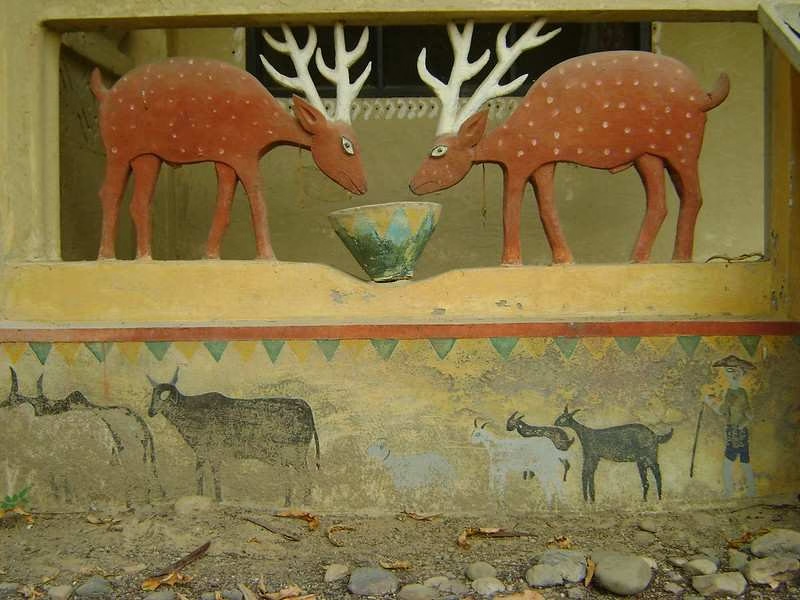
The artistic tradition is a riveting interplay of mythology, nature, and happenings of day-to-day life that has developed an exclusively visual language both bewitched art connoisseurs as well as scholars.
What is Tharu Art?
Tharu Art is a traditional form of folk art practiced by the Tharu community, primarily residing in the Terai region of Uttar Pradesh.
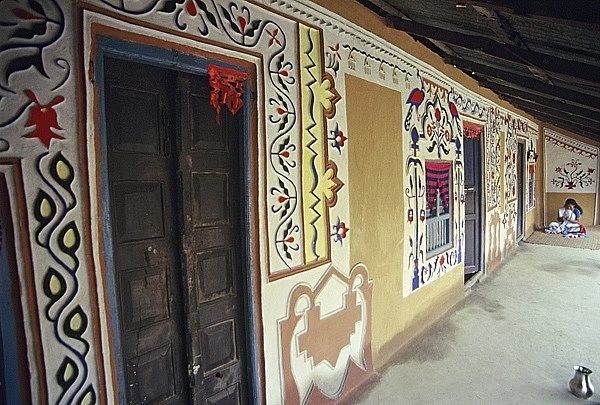
This art form is known for its intricate designs, bold colors, and deep symbolism. It reflects the community’s connection to nature, spirituality, and their agrarian lifestyle.
Types of Tharu Art
1. Tharu Wall Paintings (Bhitti Chitra)
Tharu wall paintings are vibrant expressions of daily life, spirituality, and nature. These colorful murals are traditionally created on the walls of mud houses.
Themes and Motifs:
- Depictions of Hindu deities like Durga and Krishna.
- Scenes of farming, festivals, and wildlife.
- Geometric and floral patterns symbolize prosperity.
Techniques:
- Artists use natural colors from soil, charcoal, and leaves.
- The walls are plastered with cow dung for a smooth base.
Significance:
- They honor gods during festivals like Dashain and Tihar.
- They preserve the connection between art and daily life.
Wall paintings are more than decor; they reflect the vibrant Tharu soul. About 80% of households in rural Tharu communities still practice this art.
2. Tharu Woodwork
Intricately carved wooden pieces showcase Tharu’s craftsmanship and devotion.
Common Artifacts:
- Doors and windows: Decorated with floral and animal carvings.
- Household items: Wooden utensils, storage boxes, and tools.
- Decorative objects: Miniature animals and jewelry boxes.
Artistic Approach:
- Artists use local wood, like sal and sissoo.
- Patterns are inspired by nature and myths.
Woodwork symbolizes Tharu pride and resourcefulness, passed through generations.
3. Tharu Jewelry
Tharu women adorn themselves with handcrafted jewelry, reflecting their rich heritage.
Materials and Designs:
- Silver, brass, and beads.
- Necklaces (Haar), earrings (Jhinka), and bangles (Chura).
Emotional Connection:
- Jewelry represents marital status and community identity.
- It is often worn during festivals and ceremonies.
4. Tharu Pottery
Traditional pottery sustains the Tharu way of life and celebrates the earth’s abundance.
Common Items:
- Pots for water storage and cooking.
- Decorative items for rituals and festivals.
Process:
- Clay is collected, shaped, and fired in kilns.
- Designs are minimal yet elegant.
Over 60% of Tharu households still use clay utensils daily.
5. Tharu Textile Art
Tharu women weave intricate patterns into their clothing, combining utility with beauty.
Key Items:
- Clothing: Traditional dhotis and blouses with embroidery.
- Bags and shawls: Handwoven with bright colors.
Cultural Value:
- Textiles are part of dowries.
- Designs often narrate folklore and daily life.
Tharu art forms are not just crafts; they are living stories of resilience, beauty, and joy. By embracing their traditions, the Tharu people keep their identity alive in every brushstroke, carving, and thread.
Origin and Evolution of Tharu Art
The origins of Tharu Folk Art can be traced back centuries and are deeply rooted in the community’s cultural and spiritual practices. Initially, the art was a means to appease deities and protect against evil spirits.
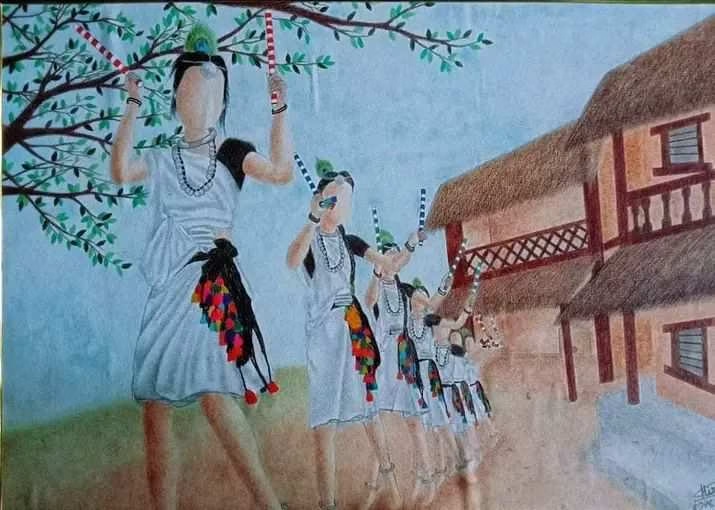
Over time, it evolved into a vibrant form of self-expression, reflecting the community’s values, beliefs, and experiences.
- Ancient Beginnings: Tharu art started as a ritualistic practice, with early forms of wall paintings and body tattoos designed to invoke divine blessings.
- Influence of Mythology: The epic of Ramayana and other Indian myths greatly influenced Tharu art. Scenes depicting the life of Lord Ram, battles with demons, and divine interventions became common motifs.
- Colonial Era: During British rule, the Tharu community’s isolation allowed their art to preserve its authenticity, even as other regional arts were influenced by Western styles.
- Modern Day: Today, Tharu Folk Art is celebrated for its cultural significance. Efforts are being made to preserve and promote this art form through exhibitions, workshops, and cultural festivals.
Significance in Uttar Pradesh
Tharu Folk Art holds a special place in the cultural tapestry of Uttar Pradesh. It is not only a reflection of the Tharu community’s identity but also a valuable part of the state’s artistic heritage.
- Cultural Identity: For the Tharu people, this art is a source of pride and a means of preserving their unique cultural identity.
- Tourism Boost: The vibrant and distinctive nature of Tharu Folk Art attracts tourists, contributing to the local economy and promoting cultural exchange.
- Educational Value: Schools and cultural organizations use Tharu art to educate young generations about the importance of preserving traditional art forms.
Statistics
- 80% of Tharu Households: Involve in a traditional activity of the art to illustrate how this ethnic heritage is practiced by so many.
- Yearly Festivals: The number of cultural festivals introducing tharu art has grown by an average of 50% over the past decade, demonstrating the bonding & igniting interest in this art form.
Tharu Folk Art is a testament to the resilience and creativity of the Tharu community. Its vibrant colors, intricate patterns, and deep-rooted symbolism make it a captivating art form that continues to enrich the cultural landscape of Uttar Pradesh.
Tharu Art: A Mosaic of Colors and Epic of Ramayana
Tharu Art is a captivating blend of vibrant colors and intricate patterns, deeply influenced by Indian mythology, particularly the epic of Ramayana.
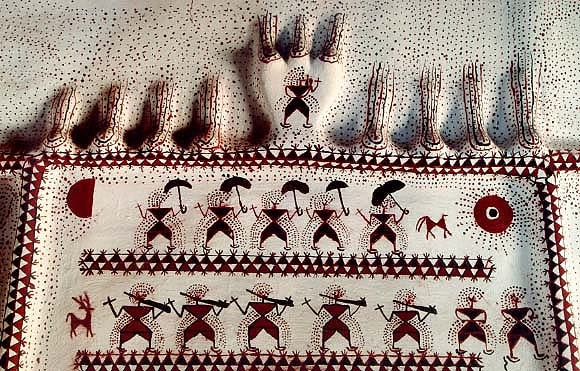
The Vibrant Color Palette of Tharu Art
Tharu art is renowned for its bold and bright colors, which are not just visually appealing but also hold symbolic significance. The color palette includes:
- Red: Symbolizing energy, passion, and life.
- Yellow: Representing happiness, spirituality, and prosperity.
- Green: Denoting nature, growth, and fertility.
- Blue: Signifying calmness, protection, and divinity.
- Black and White: Often used to highlight details and create contrast.
These colors are derived from natural sources like minerals, plant extracts, and soil, reflecting the Tharu community’s close connection with nature.
Intricate Patterns Inspired by Indian Mythology
Tharu art has intricate patterns, mostly derived from Indian mythology, and the stories depicted in them are, in large part, inspired by Indian mythology. Ramayana is one of the epics, and its origin can be found at the core of Tharu culture.
- Scenes from Ramayana: Depictions of key events, such as the battle between Rama and Ravana, the abduction of Sita, and Hanuman’s adventures are common themes.
- Divine Figures: Gods and goddesses like Rama, Sita, Lakshmana, and Hanuman are frequently portrayed, showcasing their divine attributes and heroic deeds.
- Floral and Geometric Designs: These are used to frame the mythological scenes, adding a decorative touch and enhancing the overall aesthetic.
The Storytelling Aspect of Tharu Art
Tharu art is not just for decoration; it’s the ultimate gospel in the form of painting. The various pieces–of scarves to wear, of embroidery to be done, of stories to weave — all narrate epic from Ramayana to local folklore, maintaining the cultural legacy of the community.
- Narrative Murals: Large wall murals often depict entire stories, with each panel representing different scenes from the epic.
- Symbolic Tattoos: Traditional tattoo art, known as ‘Godna,’ includes motifs that tell stories of protection and blessings from the gods.
Exploring Tharu Art in India: A Legacy of Beauty and Culture
Tharu art, one of the many tribal art forms in India, is a supreme specimen of tribal art. This form of art is inspired by the creativity of the Tharu community from the Terai region. Colorful, ornate, and nature-centric is how it is best described to the very core.
Since then, this style has been employed in monuments, temples, and, above all, ancient structures, giving a remarkable architectural milestone to the country.
Here are the eight important Tharu Art places, Ayodhya-Shri Ram Mandir, etc, as below
1. Shri Ram Mandir, Ayodhya
- Significance: One of the most sacred Hindu temples dedicated to Lord Ram.
- Tharu Influence: Tharu art is reflected in the temple’s interior decorations, showcasing traditional motifs and natural patterns. The use of earthy tones and floral designs enhances the spiritual ambiance.
- Statistics: This grand temple is set to attract millions of devotees annually, with a projected cost of over ₹900 crore for its construction.
2. Chitwan National Park’s Adjacent Areas
- Location: Near the India-Nepal border, including Tharu villages in Uttar Pradesh and Bihar.
- Artistic Significance: Traditional mud houses adorned with Tharu art demonstrate the community’s harmonious relationship with nature. These houses feature hand-painted walls with patterns of birds, animals, and daily life.
- Preservation Efforts: Initiatives are underway to preserve these structures as part of cultural tourism.
3. Bada Imambara, Lucknow
- Historical Relevance: A majestic 18th-century architectural marvel in Uttar Pradesh.
- Tharu Art Influence: The intricate floral and geometric patterns seen in parts of the structure reflect the aesthetics of Tharu artistry. It blends seamlessly with Mughal design elements.
- Visitor Statistics: Receives over 1.5 million visitors annually.
4. Barahi Temple, Banaras
- Religious Importance: Dedicated to Goddess Barahi, this ancient temple is a vital pilgrimage site.
- Tharu Art Highlights: Vibrant murals and decorative elements inside the temple bear the hallmark of Tharu creativity, particularly in their depiction of mythological scenes.
- Local Engagement: The temple serves as a hub for promoting Tharu craftsmanship.
5. Tharu Cultural Museum, Gorakhpur
- Purpose: A museum dedicated to preserving Tharu heritage and traditions.
- Key Features: The museum houses artifacts, murals, and models of Tharu-style structures. The vivid paintings demonstrate the versatility of Tharu art.
- Educational Value: Offers workshops and interactive sessions for visitors.
6. Ramnagar Fort, Varanasi
- Historical Significance: A 17th-century sandstone fortress along the Ganges River.
- Artistic Contributions: The fort’s courtyards and corridors feature Tharu-inspired patterns, blending tribal art with royal architecture.
- Tourism Impact: It’s a popular tourist attraction, drawing art and history enthusiasts alike.
7. Kushinagar Temples
- Buddhist Heritage: Known for being the site of Lord Buddha’s Mahaparinirvana.
- Tharu Art Incorporation: The temples and surrounding structures display Tharu motifs, symbolizing peace and connection with nature.
- Cultural Harmony: These elements highlight the synergy between Buddhist philosophy and tribal artistry.
8. Tharu Village Homes, Lakhimpur Kheri
- Authentic Showcase: Traditional homes in Lakhimpur Kheri district stand as living examples of Tharu artistry.
- Decorative Features: Mud walls painted with vibrant hues and intricate designs narrate stories of the community’s life and environment.
- Visitor Experience: Tourists can participate in workshops and learn the techniques of Tharu painting.
Why Tharu Art Matters
- Cultural Identity: Reflects the Tharu community’s traditions and worldview.
- Sustainability: Made with eco-friendly materials like natural dyes and mud.
- Tourism: Boosts cultural tourism and creates opportunities for local artisans.
Conclusion
Uttar Pradesh Folk Art-Tharu is a beautiful combination of strong colors, rich patterns, and mythology soaked in its roots. This fascinating art reflects all the cultural knowledge and spiritual depth available from the Tharu community in the most unique form.
We urgently need to conserve and promote Tharu Folk Art in the changing world. We celebrate and sustain this beautiful tradition to continue; the story of the Tharu community and their beliefs will survive alongside artistic expressions.
When we enjoy the beauty and relevance of Tharu Folk Art, the beauty and the long-standing tradition of traditional art come to our fore. Please cherish the cultural pearls like this one and let their heritage survive through generations!
For further reading on the significance of Tharu art, you can visit these useful resources:
Check out our Blog Page on Traditional Indian art.

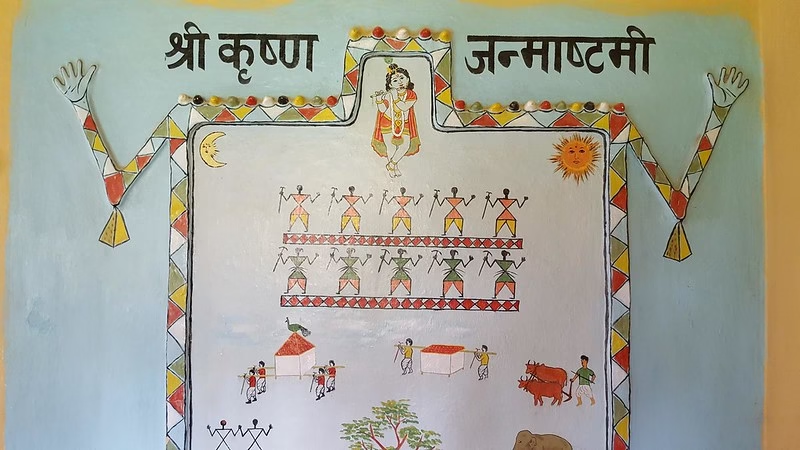
Leave a Reply